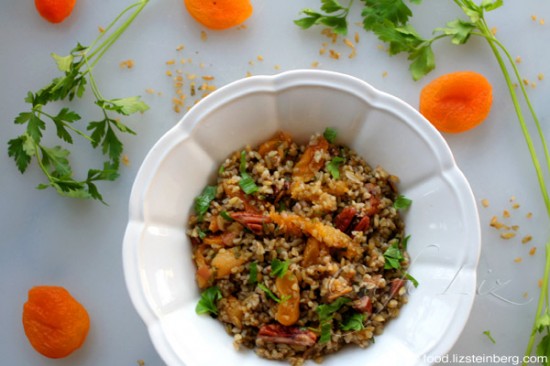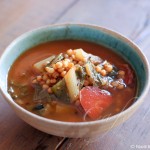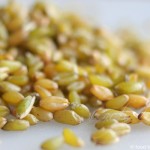
Green wheat is one of the oldest methods of eating grains known to mankind. It’s been grown and prepared in this region for thousands of years. It was used in biblical offerings. Before there was rice, there was green wheat.
In fact, unlike rice, green wheat is grown and processed locally. When I go to the market, the barrel of green wheat came from the Galilee — not from another continent, like most of our grains and legumes.
In Israel, green wheat is generally known as freekeh, its Arabic name. It has a proper Hebrew name, though, dating from the time of the Bible — carmel, like the mountain. It’s also known as kalu in Hebrew, explained Abbie from Galilee Seasonality, meaning “roasted,” a reference to how it’s prepared.
Which brings me to the most interesting thing about green wheat — how it’s prepared. The wheat is harvested green, before it’s fully ripe, and then it’s burned. The charred chaff is cleared away, leaving the kernel. Thus the wheat, once cooked, has a light, smoky flavor. Apparently this method was developed when marauding tribes torched wheat fields — not only was the wheat not destroyed, it was perfectly edible.
In fact, this is explicitly the grain offering detailed in Leviticus 2:14: “If you bring a grain offering of firstfruits to the lord, offer crushed heads of new grain roasted in the fire.”
For a point of reference, other wheat products, such as bulgur or flour, are prepared totally differently. Bulgur is parboiled, cracked wheat; flour is made by grinding raw wheat.

So, that’s your introduction to freekeh, pronounced, yes, freaky. (The correct pronunciation may actually be closer to how the word is written in English, but that’s not how the market sellers say it.) You’ll need to wash it well before cooking, since the processing (here, at least) often leaves behind a lot of soot, pebbles and twigs.
But once you’ve done so, you’ll have a wonderfully flavorful grain that’s easy to cook and nutritionally rewarding. It’s lovely when tossed with a bit of good olive oil and salt, and it’s also lovely when mixed with any number of herbs and other ingredients.
This recipe mixes lively herbs, rich nuts and sweet dried fruit, all of which bring out a different element of this rich, somewhat herbaceous grain. Preserved lemon adds both tartness and flavor from the spices used in the pickling process. My preserved lemons are actually limequats, a kind of mini lemon known in Israel as “Chinese lemon.” I pickled them using David Leibovitz’s recipe.

For 2 large servings or 4 small servings:
1 cup green wheat (freekeh)
1.5 cups water
1/4 cup chopped dried apricots (about 8 pieces)
1/4 cup chopped pecans
2 tablespoons cured lemon (2 small ones; alternate: lemon zest + juice)
2 heaping tablespoons chopped fresh parsley
2 tablespoons good olive oil
1/4 teaspoon salt (or to taste — the lemons contain salt)
Rinse the green wheat well. Cook with the water in a covered pot on medium-low heat for about 10 minutes, until all the water is absorbed.
Chop the apricots, pecans, cured lemon and parsley. Toss all the ingredients with the cooked green wheat. Serve.
More on green wheat:
- Ynet explains all about green wheat and its history (in Hebrew).
- Sarah explains the different methods of preparing wheat.
- Dirty Kitchen Secrets offers a source for that great story about the torched wheat field.





